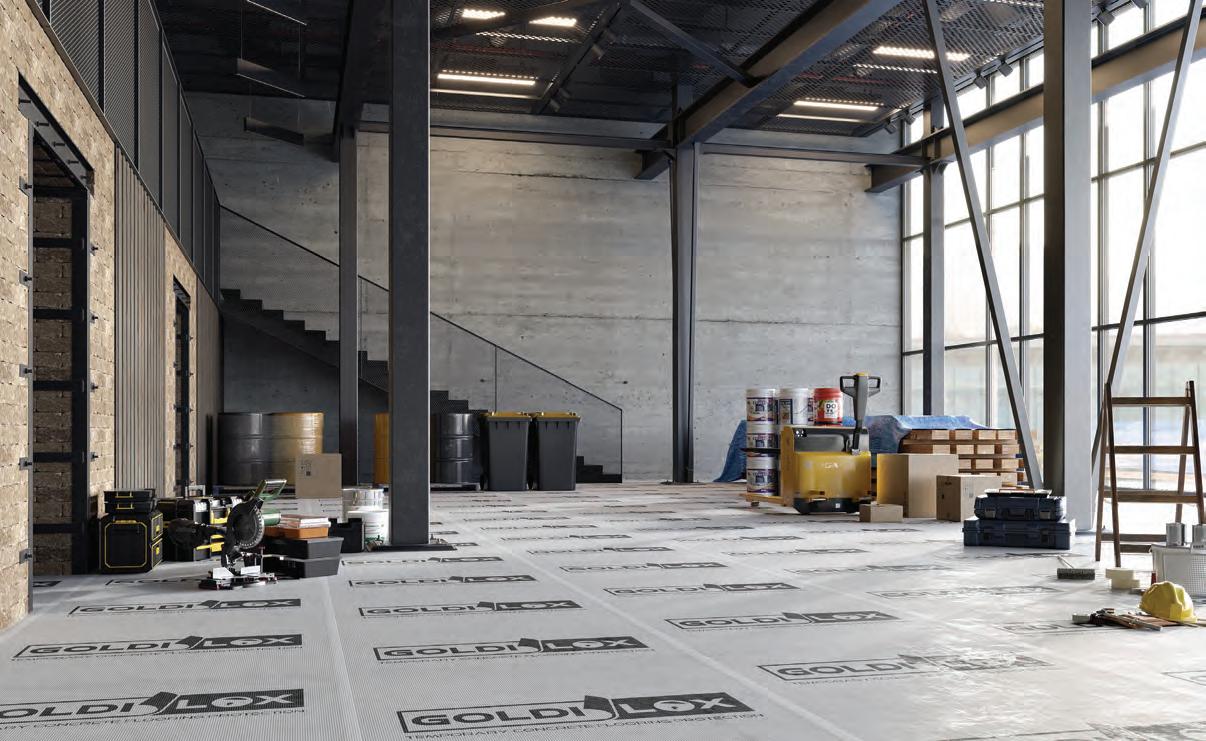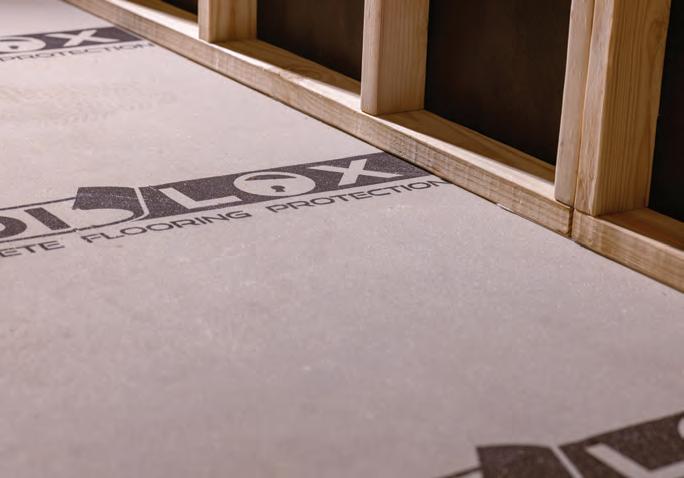
5 minute read
World of Concrete Preview
COVER STORY » BY JONATHAN KOZLOWSKI, EDITOR
Floor Protection From Construction Traffic
GoldiLox LLC | Photo by Jason Risner of Jason Risner Photography
For 20 years business partners David Harris and David Forren have attended preconstruction meetings, and for 20 years, as the building team got to the specs for polished concrete—which architects and owners love, but general contractors hate to deal with—he could all but write script.
Harris and Forren are managing partners of Riverbed Concrete, a twodecade stalwart of concrete flooring, and Slick Rock Concrete, manufacturers of precast site furnishings, fire tables, fire bowls, and water bowls. They are also most recently the inventors and managing partners of a new products company called GoldiLox, the peelable concrete floor protection about to turn the building world on its head.
“The GC is put in an impossible situation when polished concrete is specified,” Harris says. “The concrete slab is poured on day one. By the end of the project, that same surface has to be immaculate, on time, on budget—but with no sure way to protect it through the many months of heavy construction.” GoldiLox tackles this problem head-on.
CHICKEN BEFORE THE EGG
Wait a minute. Doesn’t polishing protect the floor? Why not just polish before walls go up and let the densified concrete bear the brunt of the construction abuse.
Common misconception, Harris says. And a costly one. “For 20 years at meetings we’d educate everyone on what polished concrete is and is not,” he adds. “It’s wear tolerant. It’s durable—no recoating necessary. No stripping. No rewaxing or buffing. With commercial traffic it stays looking great. But construction abuse is not normal traffic. Polished or unpolished, concrete exposed to oil leaks, oversized construction machinery, metal shavings, dropped tools, chemical spills, and industrial mishaps will absorb stains and show construction abuse in the final product.”
Why not wait to polish the floors when the construction ends to remove

GoldiLox LLC | Photo by Jason Risner of Jason Risner Photography
10 CONCRETE CONTRACTOR DECEMBER 2022

GoldiLox LLC | Photo by Jason Risner of Jason Risner Photography
construction damage? Harris says that polished concrete should not be looked upon as a magic eraser to remove construction abuse—it just doesn’t work that way. Additionally, by the time the walls are up, the electricians, plumbers, painters, drywall, and other tradespeople make the worksite dangerous and difficult to coordinate around the industrial process of grinding and polishing, resulting in hugely inefficient installation and often sub-par results.
To further complicate the argument for polishing after walls, “OSHA recently classified silica dust similar to asbestos,” the 20-year concrete veteran adds. “So many installers are choosing to grind wet. Grinding wet alleviates dust concerns, but grinding wet after walls, with the other trades on site, invites mayhem. “You’re trying to run an industrial process around walls, through every door jamb and opening,” Harris says. “If it’s a new school building, for instance, you’re talking in and out of 100s of classrooms. The process becomes slow and broken.”
For a GC with an eye on budgets, installation quality, deadlines, as well as safety, the ideal is to polish early, uniformly, in an open field of concrete and then frame on top of it. No edging by hand needed, no more hand grinding those last inches near the wall (which never matches the field of the concrete). Fewer inconsistencies in clarity, shine, and uniformity while gaining significant improvements to production rates.
TRADITIONAL PROTECTION
For protection, some contractors in the first months will use OSB (oriented strand board) or plywood, with all the usual plywood problems. “It curls and bows in rain and trips people up,” Harris says. “Leaving it on the slab can often produce ghosting in the finished flooring. The open seams allow in oil and acidic spills. And the cost of sheet goods right now is through the roof.”
Though cardboard is lightweight and typically inexpensive, Harris doesn’t believe it offers enough of a barrier to protect the polished floors. He calls it a “non-starter” especially for the first months of heavy construction, before dry-in. “As soon as you pour, the cranes, lifts, big equipment, and abusive trades are there,” Harris explains. “You can’t tape cardboard to the GoldiLox LLC | Photo by Jason Risner of Jason Risner Photography concrete. It has seams and doesn’t stay down, so dust, metal shavings, dirt, and oil slip in. It turns to mush when wet. The earliest cardboard can go down is after the roof, doors, and windows are up—often months after work begins, and by then the contractor has missed the critical stages of protecting against heavy construction.”
He’s also found rolls and sheets of plastic ineffective, explaining that “plastic almost always results in ghosting. It’s not seamless, meaning debris and liquids can easily get under it. On top of that, a slip-andtrip hazard.” For 20 years, by the end of a precon, he explains that he and the GC would lock eyes, one looking pained, the other resigned. Ultimately the GC would ask the big question, “With the budget I’ve got, how the heck do I make sure the concrete I pour next week will look good when I turn the building over to the owner?” For 20 years, the industry’s best answer has been a shrug.
RESULTS
For a time Riverbed Concrete tried to protect its newly polished floors with a glue-down product. “It’s a great product but with labor, can easily be as much as twice the cost of the floor we’d put in,” Harris says. “Protection is too rarely specified, and builders tend to budget for cardboard, so overly priced alternatives like that can’t come in after the fact.” This got the Riverbed team thinking. “If we could develop an effective, budget-friendly form of protection we could dramatically improve our polishing production, become more competitive not only in cost but by delivering

www.ForConstructionPros.com/Concrete DECEMBER 2022 CONCRETE CONTRACTOR 11










